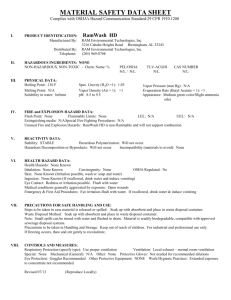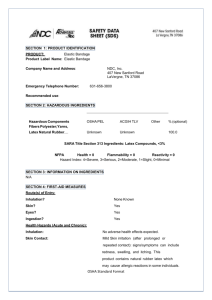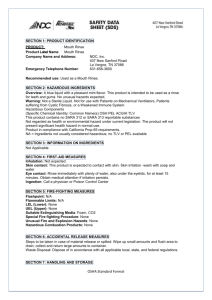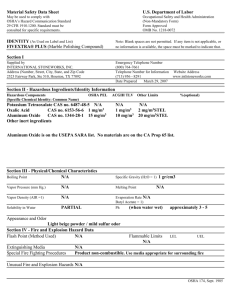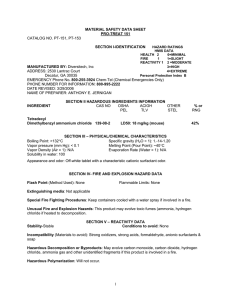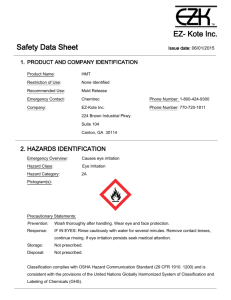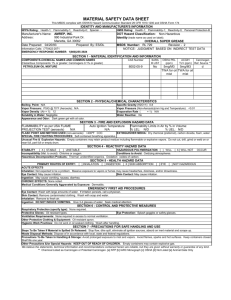Naxell™ Polycarbonate Resin
advertisement
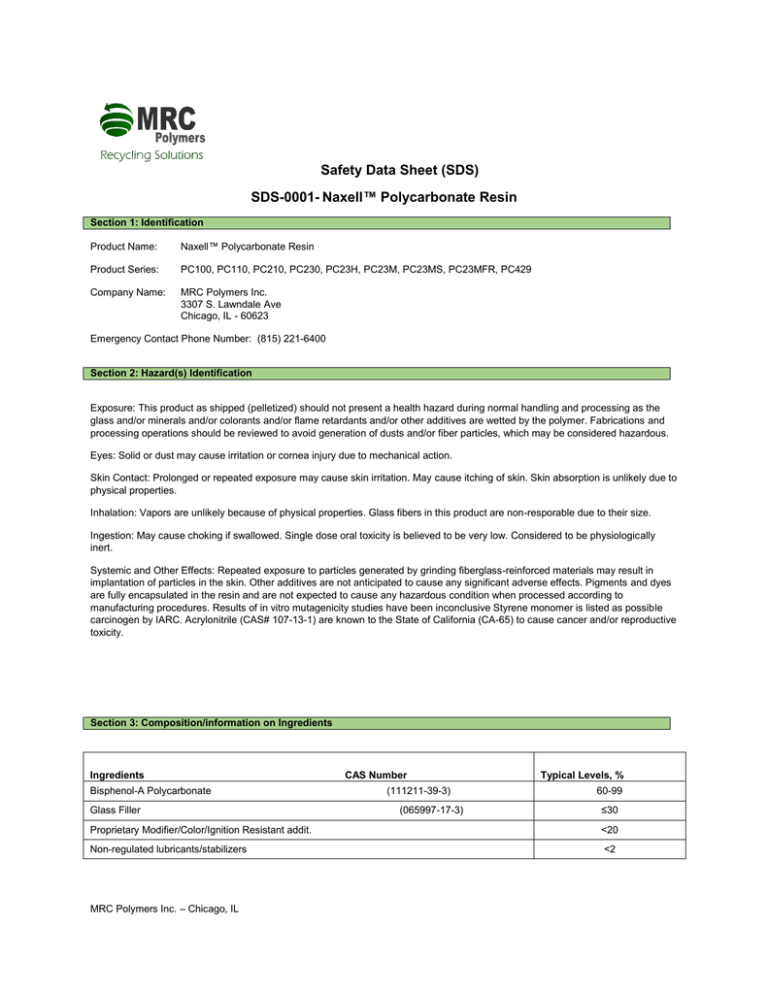
Safety Data Sheet (SDS) SDS-0001- Naxell™ Polycarbonate Resin Section 1: Identification Product Name: Naxell™ Polycarbonate Resin Product Series: PC100, PC110, PC210, PC230, PC23H, PC23M, PC23MS, PC23MFR, PC429 Company Name: MRC Polymers Inc. 3307 S. Lawndale Ave Chicago, IL - 60623 Emergency Contact Phone Number: (815) 221-6400 Section 2: Hazard(s) Identification Exposure: This product as shipped (pelletized) should not present a health hazard during normal handling and processing as the glass and/or minerals and/or colorants and/or flame retardants and/or other additives are wetted by the polymer. Fabrications and processing operations should be reviewed to avoid generation of dusts and/or fiber particles, which may be considered hazardous. Eyes: Solid or dust may cause irritation or cornea injury due to mechanical action. Skin Contact: Prolonged or repeated exposure may cause skin irritation. May cause itching of skin. Skin absorption is unlikely due to physical properties. Inhalation: Vapors are unlikely because of physical properties. Glass fibers in this product are non-resporable due to their size. Ingestion: May cause choking if swallowed. Single dose oral toxicity is believed to be very low. Considered to be physiologically inert. Systemic and Other Effects: Repeated exposure to particles generated by grinding fiberglass-reinforced materials may result in implantation of particles in the skin. Other additives are not anticipated to cause any significant adverse effects. Pigments and dyes are fully encapsulated in the resin and are not expected to cause any hazardous condition when processed according to manufacturing procedures. Results of in vitro mutagenicity studies have been inconclusive Styrene monomer is listed as possible carcinogen by IARC. Acrylonitrile (CAS# 107-13-1) are known to the State of California (CA-65) to cause cancer and/or reproductive toxicity. Section 3: Composition/information on Ingredients Ingredients Bisphenol-A Polycarbonate Glass Filler CAS Number (111211-39-3) (065997-17-3) Typical Levels, % 60-99 ≤30 Proprietary Modifier/Color/Ignition Resistant addit. <20 Non-regulated lubricants/stabilizers <2 MRC Polymers Inc. – Chicago, IL The resin in specifically designated colors may contain commercially available dyes and pigments, generally at levels less than 1 percent, but sometimes at levels greater than 1 percent, including titanium dioxide, carbon black, iron oxides, ultra marine, and other insoluble metal salts at less than 5 percent. This document is prepared pursuant to OSHA Hazard Communication Standard (29 CFR 1910.1200). In addition, other substances not hazardous to this OSHA standard may be listed. Where proprietary ingredient shows, the identity of this substance may be made available as provided in 29 CFR 1910.1200 (I). Section 4: First-aid Measures Eyes: Remove contact lenses at once. Flush with water, lifting upper and lower lids occasionally. Seek medical attention. Skin: Contact with molten resin can cause severe thermal burns. Cool rapidly with water and immediately seek medical attention. Do not attempt removal of plastic without medical assistance. Do not use solvent for removal. Ingestion: No adverse effects anticipated by this route of exposure incidental to proper industrial handling. If a large amount is swallowed, seek medical attention. Inhaled: No adverse effects anticipated by this route of exposure. Section 5: Fire-fighting Measures Fire-Fighting Procedures: Wear self-contained breathing apparatus with a full-face piece operated in the positive pressure demand mode and full body protection when fighting fires. Water may be used to keep fire-exposed containers cool until fire is out. Section 6: Accidental Release Measures Emergency Action: No special environmental precautions required. Spill/Leak Procedure: Containment of this material should not be necessary. Sweep up or gather material and place in appropriate container for disposal. Section 7: Handling and Storage Practice reasonable care and cleanliness. Ventilation should be provided at processing machinery to control fumes. There should be proper dust collection systems in place to avoid any dust accumulation. Store in a dry place away from moisture, excessive heat and source of ignition. Section 8: Exposure Controls/Personal Protection Skin: Wear clean, long-sleeved, body-covering clothing. Under dry conditions, cloth gloves should provide adequate protection from molten plastic. If molten polymer gets in contact with the skin, cool rapidly with water and do not attempt to remove plastic without medical assistance. Seek immediate medical attention. Respiratory: If handling at elevated temperatures and overexposure has been determined, an air-respirator is advised in the absence of proper environmental control. Ventilation: Provide sufficient mechanical ventilation to maintain exposure level below the level of over exposure. Seek immediate medical attention of any symptom like coughing, difficulties in breathing or any other problem develops. Eyes: Wear safety glasses in compliance with OSHA regulations. MRC Polymers Inc. – Chicago, IL Section 9: Physical and Chemical Properties Boiling Point: Not applicable Vapor Pressure: Not applicable Specific Gravity (H20=1): 1.19 - 1.43 Percent Volatile: Not applicable Appearance: Natural or tinted or opaque solid Odor: Slight Section 10: Stability and Reactivity Hazardous Polymerization: Will not occur. Stability: Polymer decomposes above 350º C (662º F). Incompatibility: None known . Hazardous Decomposition Products: Carbon dioxide/ monoxide, phenolic compounds, hydrocarbons, acrylates at elevated temperatures. Section 11: Toxicological Information Likely Routes of Exposure: Eyes and skin contact. Acute Effects: Irritation of eyes and skin. Oral Toxicity LD50 Not Available; Inhalation Toxicity LD50 Not Available. Chronic Effects: None known. Symptoms: Irritation of eyes and skin. Carcinogenicity: This product has not been found to be carcinogenic by the NTP, ACGIH, IARC or OSHA. Further information This product has no known adverse effect on human health Section 12: Ecological Information MRC Polymers Inc. – Chicago, IL US Department of Transportation (D.O.T) and Canadian TDG, does not regulate this product when shipped domestically by land. Section 13: Disposal Considerations Spills and leaks: To prevent falls sweep up spills and place in waste container. Incinerate or dispose of in accordance with all applicable local, state and federal regulations. Disposal Method: Any disposal practice must be in accordance with local, state, and federal regulations. For unused or uncontaminated material, the preferred disposal options are to send to a licensed recycler, reclaimer, or incinerator. The same disposal options are recommended for used, or contaminated material, but additional evaluation is required. Disposal method must be in compliance with all Federal, State and Local laws. Do not dump into any sewers, on the ground or into any body of water. For unused product contact a waste management companies or a licensed recycler. Section 14: Transport Information US Department of Transportation (D.O.T) and Canadian TDG, does not regulate this product when shipped domestically by land. Section 15: Regulatory Information The information in this document is provided with good intentions and believed to be accurate, but no warranty is expressed or implied. Recipients are advised to confirm in advance of the need that the information is current, applicable, and suitable to their circumstances. Recipients are responsible for ensuring that its activities are in accordance with local, state and federal regulations. SARA HAZARD CATEGORY: Not to have met any hazard category TOXIC SUBSTANCES CONTROL ACT (TSCA) and Canadian Domestic Substance List (DSL): All ingredients are on the TSCA/DSL inventory or not required to be listed on the TSCA/DSL inventory. THE OCCUPATIONAL SAFETY AND HEALTH ADMINISTRATION (OSHA): This product is not a “hazardous Chemical” as defined by the OSHA hazard communication standard, THE CANADIAN WORKPLACE HAZARDOUD Materials information system (WHMIS) classification: Not a “Controlled Product” under WHMIS. CALIFORNIA PROPOSITION 65 (CA-65): MRC does not add intentionally any chemical known to State of California under the California Proposition 65 list. This product will not necessarily cause cancer or reproductive harm if used as designed. Section 16: Other Information Abbreviations: OSHA: The Occupational Safety and Health Administration. CAS #: Chemical Abstracts Service number. CA-65: California Proposition 65 (Safe Drinking Water & Toxic Enforcement Act) RCRA: Resource Conservation and Recovery Act. NFPA: National Fire protection Association. MRC Polymers Inc. – Chicago, IL
